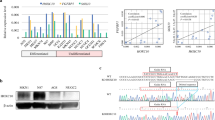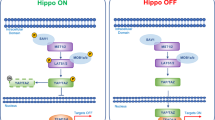Abstract
Background
The Hippo (Hpo) pathway is highly conserved in humans and was originally uncovered in Drosophila as a potent regulator of inhibiting cell growth and promoting apoptosis. The Hippo pathway consists of a tumor suppressor kinase cascade that negatively regulates growth and results in inactivation of a transcriptional co-activator, Yorkie (yki). The human ortholog of Yki, the yes-associated protein (YAP), has a 31% sequence identity and similar biologic activity. The potential role of YAP in tumorigenesis was also reported in a murine genetic screen which identified a genomic amplification of YAP in hepatocellular carcinoma.
Aim
Given this pathway’s critical control of cell growth, survival, proliferation, and amplification in malignancy, we wanted to explore the possible role of the Hippo pathway in human esophageal and gastric tumorigenesis.
Method
The expression of YAP was evaluated with immunolabeling of esophageal and gastric tissue microarrays from 169 patients, with nondysplastic, dysplastic, and malignant foci represented. Cytoplasmic and nuclear staining were scored as 0 = none, 1 < 10%, 2 = 10–50%, and 3 > 50% for the nonneoplastic, dysplastic, and malignant epithelium. Multiple scores were averaged for each patient. Expression of YAP could be seen in the proliferating compartments of nonneoplastic tissue.
Results
Compared to nonneoplastic epithelium, there was a significant increase in YAP cytoplasmic and nuclear localization in high-grade dysplastic epithelium and adenocarcinoma of the esophagus. There was also a significant increase in YAP cytoplasmic and nuclear staining of gastric carcinoma and metastatic gastric disease compared to nonneoplastic gastric tissue.
Conclusions
YAP expression in the cytoplasm and nucleus is significantly increased in high-grade dysplasia and adenocarcinoma of the esophagus as well as gastric adenocarcinoma and metastatic gastric disease, suggesting a role for this recently uncovered pathway in esophageal and gastric epithelial tumorigenesis.






Similar content being viewed by others
References
Jemal A, Tiwari RC, Murray T, Ghafoor A, Samuels A, Ward E, et al. Cancer statistics, 2004. CA Cancer J Clin 2004;54:8–29.
Brown LM, Devesa SS. Epidemiologic trends in esophageal and gastric cancer in the United States. Surg Oncol Clin N Am 2002;11:235–56.
Lagergren J, Bergstrom R, Lindgren A, Nyren O. Symptomatic gastroesophageal reflux as a risk factor for esophageal adenocarcinoma. N Engl J Med 1999;340:825–31.
Enzinger PC, Mayer RJ. Esophageal cancer. N Engl J Med 2003;349:2241–52.
Buttar NS, Wang KK, Sebo TJ, Riehle DM, Krishnadath KK, Lutzke LS, et al. Extent of high-grade dysplasia in Barrett’s esophagus correlates with risk of adenocarcinoma. Gastroenterology 2001;120:1630–9.
Conio M, Blanchi S, Lapertosa G, Ferraris R, Sablich R, Marchi S et al. Long-term endoscopic surveillance of patients with Barrett’s esophagus. Incidence of dysplasia and adenocarcinoma: a prospective study. Am J Gastroenterol 2003;98:1931–9
Montgomery E, Bronner MP, Goldblum JR, Greenson JK, Haber MM, Hart J, et al. Reproducibility of the diagnosis of dysplasia in Barrett esophagus: a reaffirmation. Hum Pathol 2001;32:368–78.
Reid BJ, Levine DS, Longton G, Blount PL, Rabinovitch PS. Predictors of progression to cancer in Barrett’s esophagus: baseline histology and flow cytometry identify low- and high-risk patient subsets. Am J Gastroenterol 2000;95:1669–76.
Weston AP, Sharma P, Topalovski M, Richards R, Cherian R, Dixon A, et al. Long-term follow-up of Barrett’s high-grade dysplasia. Am J Gastroenterol 2000;95:1888–93.
Crew KD, Neugut AI. Epidemiology of upper gastrointestinal malignancies. Semin Oncol 2004;31:450–64.
Edgar BA. From cell structure to transcription: Hippo forges a new path. Cell 2006;124:267–73.
Pan D. Hippo signaling in organ size control. Genes Dev 2007;21 8:886–97.
Wu S, Huang J, Dong J, Pan D. Hippo encodes a Ste-20 family protein kinase that restricts cell proliferation and promotes apoptosis in conjunction with salvador and warts. Cell 2003;114:445–56.
Huang J, Wu S, Barrera J, Matthews K, Pan D. The Hippo signaling pathway coordinately regulates cell proliferation and apoptosis by inactivating Yorkie, the Drosophila Homolog of YAP. Cell 2005;122:421–34.
Sudol M. Yes-associated protein (YAP65) is a proline-rich phosphoprotein that binds to the SH3 domain of the Yes proto-oncogene product. Oncogene 1994;9 8:2145–52.
Sudol M, Chen HI, Bougeret C, Einbond A, Bork P. Characterization of a novel protein-binding module-the WW domain. FEBS Lett 1995;369 1:67–71.
Basu S, Totty NF, Irwin MS, Sudol M, Downward J. Akt phosphorylates the Yes-associated protein, YAP, to induce interaction with 14-3-3 and attenuation of p73-mediated apoptosis. Mol Cell 2003;11 1:11–23.
Zender L, Spector MS, Xue W, Flemming P, Cordon-Cardo C, Silke J, et al. Identification and validation of oncogenes in liver cancer using an integrative oncogenomic approach. Cell 2006;125:1253–67.
Manley S, Mucci NR, De Marzo AM, Rubin MA. Relational database structure to manage high-density tissue microarray data and images for pathology studies focusing on clinical outcome: the prostate specialized program of research excellence model. Am J Pathol 2001;159:837–43.
Sampliner RE. Updated guidelines for the diagnosis, surveillance, and therapy of Barrett’s esophagus. Am J Gastroenterol 2002;97:1888–95.
Acknowledgements
This work was supported by grants from the National Institutes of Health to D.J.P. (EY015708), A.M. (R01CA113669 and R21DK072532), and R.A.A. (DK067187).
Author information
Authors and Affiliations
Corresponding author
Rights and permissions
About this article
Cite this article
Lam-Himlin, D.M., Daniels, J.A., Gayyed, M.F. et al. The Hippo Pathway in Human Upper Gastrointestinal Dysplasia and Carcinoma: A Novel Oncogenic Pathway. J Gastrointest Canc 37, 103–109 (2006). https://doi.org/10.1007/s12029-007-0010-8
Published:
Issue Date:
DOI: https://doi.org/10.1007/s12029-007-0010-8




